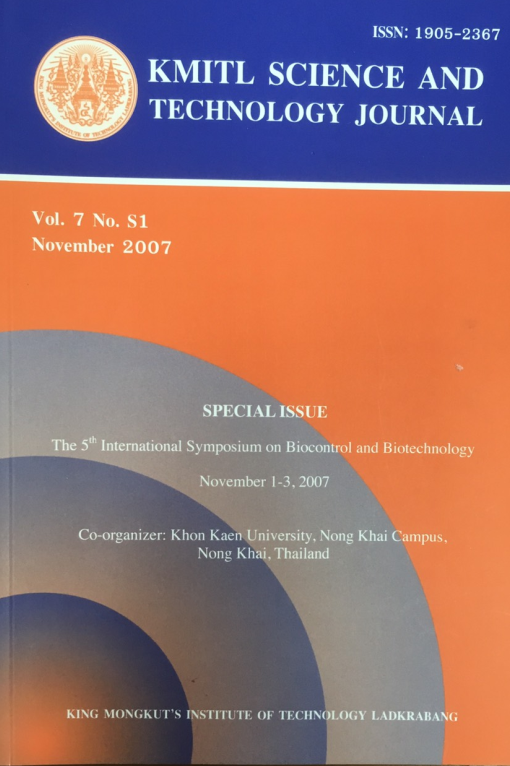IMPROVING VIABILITY OF FREEZE-DRIED LACTIC ACID BACTERIA USING LYOPROTECTANTS IN COMBINATION WITH OSMOTIC AND COLD ADAPTATION
Main Article Content
Abstract
Effect of lyoprotectants on survival of Lactococcus lactis and Lactobacillus sakei after freeze drying was investigated. Their survivals in 9.1% w/w of skim milk, soy milk, egg yolk, sucrose, lactose, glucose, trehalose and sorbitol were compared, and the protectants caused high viability were selected to develop formulations of mixed protectants. Compared to soy milk and sorbitol, higher viability of L. lactis was observed with lactose, skim milk and sucrose. For freeze-dried L. sakei, the survival in skim milk and soy milk was greater than that in trehalose, sucrose and lactose. Among all protectants tested, glucose and egg yolk provided the lowest protection to these bacteria. Of all lyoprotectant formulations, the highest number of L. lactis survivors was found in mixed lyoprotectants containing 3.97 g lactose, 3.97 g sucrose, 3.97 g trehalose, 8.73 g skim milk and 79.36 g distilled water. The protectant mixture provided the highest viability of L. sakei contained 3.97 g lactose, 3.97 g sucrose, 3.97 g trehalose, 8.73 g skim milk and 79.40 g soy milk with distilled water (1:1). Compared to single protectant, the number of L. lactis and L. sakei survivors in these formulations was increased by 11.69-20.15% and 9.51-18.15%, respectively. To improve viability, osmotic adaptation alone (with 0.3 M sucrose) or in combination with cold adaptation (10°C) induced cross-protection of L. lactis and L. sakei in selected protectant mixtures after freeze drying and storage for 28 days at -80°C were studied. These adaptation treatments did not provide protection of L. lactis and L. sakei cells after freeze drying and storage.
Keywords: Lactococcus lactis, Lactobacillus sakei, lyoprotectant, freeze drying, adaption
Corresponding author: E-mail: knsuree@kmitl.ac.th
Article Details
Copyright Transfer Statement
The copyright of this article is transferred to Current Applied Science and Technology journal with effect if and when the article is accepted for publication. The copyright transfer covers the exclusive right to reproduce and distribute the article, including reprints, translations, photographic reproductions, electronic form (offline, online) or any other reproductions of similar nature.
The author warrants that this contribution is original and that he/she has full power to make this grant. The author signs for and accepts responsibility for releasing this material on behalf of any and all co-authors.
Here is the link for download: Copyright transfer form.pdf
References
[2] Champage, C.P., Gardner, N., Brochu, E. and Beaulieu, Y. 1991 The Freeze-drying of Lactic Acid Bacteria, A review, Canadian Institute of Science and Technology Journal, 24. 118-128.
[3] Hubálek, Z. 2003 Protectants Used in the Cryopreservation of Microorganisms, Cryobiology, 46, 205-229.
[4] Foley, D.M., Trimboli, S.L., Lamb, J., Gogley, J., Timson, J., Caporaso, F., Calicchia, M. and Prakash, A. 2005 Acid-adaptation does not Increase the Resistance of Listeria monocytogenes to Radiation in a Seafood Salad, International Journal of Food Microbiology, 99, 147-156.
[5] Panoff, J.M., Thammavongs, B., Laplace, J.M., Hartke, A., Boutibonnes, P. and Auffry, Y. 1995 Cryotolerance and Cold Adaptation in Lactococcus lactis subsp. lactis IL1403, Cryobiology, 32, 516-520.
[6] Bâati, L.,Fabre-Gea, C., Auriol, D. and Blance, J.P. 2000 Study of Cryotolerance of Lactobacillus acidophilus: Effect of Culture and Freezing Conditions on the Viability and Cellular Protein, International Journal of Food Microbiology, 59, 241-247.
[7] Girgis, H.S., Smith, J., Luchansky, J.B. and Klaenhammer, T.R. 2003 Stress adaptions of lactic acid bacteria. In: Yourself, A. E. and Juneja, V. K. Eds. Microbial Stress Adaption and Food Safety. Boca Raton, Florida, CRC Press, pp. 159-211.
[8] Riedel, L. 1972 Enthalpy- Water Content Diagram for Lean Beef (also Valid for other Meats with Fat Content below 4%): Recommendations for the Processing and Handling of Frozen Foods. Paris, The 2nd International Institute of Refrigeration (IIR).
[9] Carpenter, J.F. and Crowe, J.H. 1989. An Infrared Spectroscopic Study of the Interactions of Carbohydrates with Dried Proteins, Biochemistry, 28, 3916-3922.
[10] Chavarri, F.J., Paz, M.D. and Neez, M.M. 1988 Cryoprotective Agents for Frozen Concentrated Starter from Non-bitter Streptococcus lactis strains, Biotechnology Letters, 10, 10-16.
[11] Winton, A.L. and Winton, K.B. 2002 Milk and Milk Products. Jodhpur, Agrobios (India).
[12] Sian, N.K. and Ishak, S. 1992 Effect of pH on Yield, Chemical Composition and Boiling Resistance of Soybean Protein-lipid Film, Cereal Food World, 35, 748-752.
[13] Miyajima, K. 1997 Role of Saccharides for the Freeze-thawing and Freeze-drying of Liposomes, Advanced Drug Delivery Reviews, 24, 151-159.
[14] Font de Valdez, G., de Giori, G., de Ruiz Holgado, A. P. and Oliver, G. 1983 Protective Effect of Adonitol on Lactic Acid Bacteria Subjected to Freeze-drying, Journal of Applied Bacteriology, 66, 365-378.
[15] Palmfeldt, J., Rådström, P. and Hahn-Hägerdal, B. 2003 Optimisation of Initial Cell Concentration Enhances Freeze-drying Tolerance of Pseudomonas chlororaphis, Cryobiology, 47, 21-29.
[16] Glaasker, E., Konings, W.N. and Poolman, B. 1996 Glycine Betaine Fluxes in Lactobacillus plantarum during Osmostasis and Hyper- and Hypo- osmotic Shock, Journal of Biological Chemistry, 271, 10060-10065.
[17] Yancey, P.H., Clark, M.F., Hand, S.C., Bowlus, R.D. and Somero, G.N. 1982 Living Water Stress Evolution of Osmolyte Systems, Science, 217, 1214-1227.
[18] Csonka, L.N. 1989 Physiological and Genetic Responses of Bacteria to Osmotic Stress, Microbiological Reviews, 53, 121-147.
[19] Uguen, P. Hamelin, J., Le Pennec, J.-P. and Blanco, C. 1999 Influence of Osmolarity and the Presence of an Osmoprotectant on Lactococcus lactis Growth and Bacteriocin Production, Applied and Environmental Microbiology, 65, 291-293.
[20] Panoff, J-M., Thammavongs, B., Guéguen, M. and Boutibonnes, P. 1998 Cold Stress Responses in Mesophilic Bacteria, Cryobiology, 36, 75-83.


